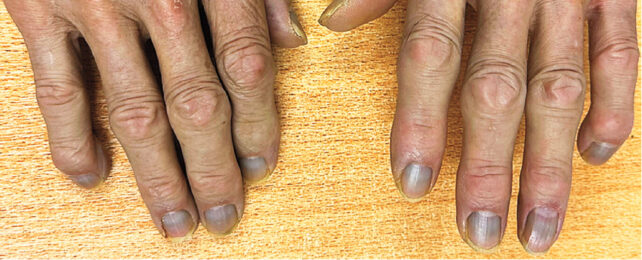
An 84-year-old man arrived at a Hong Kong medical facility with urinary obstruction complications, baffling medical practitioners due to an enigmatic grayish discoloration of his skin, eyes, and nails.
This peculiar pigmentation was not a recent development. In fact, his faintly ashen hue had reportedly persisted for five years.
Subsequent blood analysis uncovered an unusual culprit: silver. His body harbored the metal in concentrations exceeding 40 times the typical levels, with silver particles forming oxidized micro granules beneath his skin, particularly in the membranes of sweat glands, blood vessels, and dermal fibers, according to sciencealert.com.
This phenomenon, identified as argyria, involves the systemic deposition of silver within bodily tissues. Though rare, it is not entirely unprecedented. Severe cases may render large areas of exposed skin with a striking bluish tint.

Historically, individuals who worked as metalworkers or miners, frequently handling silver, were at risk of developing this condition. In other instances, the silver entered the body through medications that utilized its antimicrobial qualities.
Despite lacking scientific validation, colloidal silver is still marketed and consumed, with the US Food and Drug Administration cautioning against its use, deeming it neither a safe nor an effective remedy for any health condition, as reported by sciencealert.com.
Nonetheless, silver-based products remain globally accessible, often advertised as dietary supplements purported to detoxify or bolster immunity.
The metal is typically absorbed through inhalation, skin contact, or ingestion, where it disseminates throughout the body. Ultraviolet rays from sunlight can induce electron capture by silver ions, leading to chemical reactions that produce compounds reflecting a grayish or bluish hue.
As per the recent case study, the elderly patient was undergoing treatment for a benign prostate tumor. His only medication was finasteride, a standard antiandrogen, devoid of any silver content.
Having spent years employed as a waiter, his occupational history offered no plausible source of silver exposure. Furthermore, the absence of similar symptoms among his neighbors ruled out contamination in his residential environment.
According to the reports by sciencealert.com, fortunately, this condition appears to pose minimal risk to the patient’s long-term health. Beyond the cosmetic implications, silver accumulation is largely inert unless present at extremely high levels, where it may marginally interfere with the absorption of certain antibiotics or drugs like thyroxine.
However, the man is unlikely to reverse his slate-gray complexion. Current medical interventions offer no means of expelling accumulated silver from the body.
The precise origin of his silver exposure remains an enigma. With his diagnosis formally documented, his healthcare providers are expected to monitor his silver levels vigilantly in the years ahead.
This intriguing case was documented in The New England Journal of Medicine.
